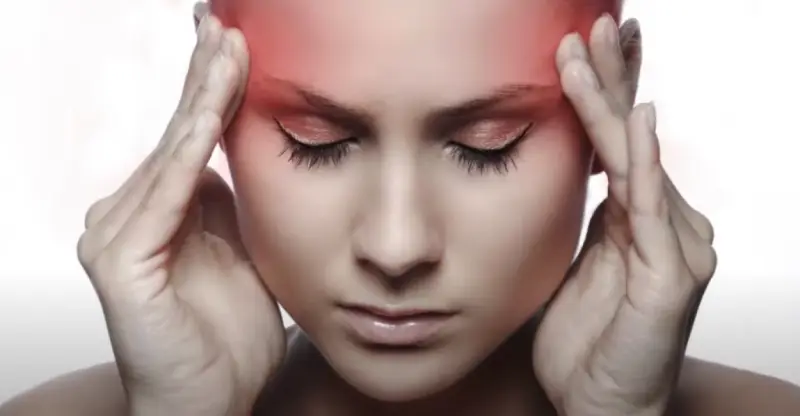While cycling, foreign particles such as dust have the potential to irritate your eyes. This irritation can cause corneal abrasions, leading to discomfort, watery eyes, and potential infections because of scratching the eyes’ clear membrane.
While cycling, your head may hurt when moving your eyes because of a combination of factors, such as eyestrain, sinus pressure, migraine, nerve damage, or tension headaches.
The repetitive motion and focusing required during cycling may exacerbate these conditions, leading to discomfort. Taking breaks and adjusting your cycling posture is essential for proper evaluation and guidance.
This blog post delves into the causes and factors behind the discomfort experienced in the head while cycling and moving your eyes. It also offers preventive measures to ease this issue.
Why My Head Hurts When I Move My Eyes While Cycling? 3 Cures

It is a healthy and fun activity to cycle, but sometimes, it can cause headaches, especially when you move your eyes. Let’s look at why this might happen.
Optic Nerve Strain
The optic nerve serves as the vital link between your eyes and brain, enabling vision by transmitting visual signals to the brain.
- How It Works: The optic nerve carries images from your eyes to your brain so you can understand what you see.
- Strain and Headaches: Moving your eyes a lot while cycling can stress the optic nerve, which can cause headaches.
Sinus Issues
Sinuses are small air-filled spaces in your skull. They help with breathing and keeping your headlight. However, they can also be a source of pain.
- Sinus Cavities: These are located in your forehead, cheeks, and around your nose.
- Pressure and Pain: When your sinuses get blocked or swollen, they create pressure. This pressure can worsen when you move your eyes, leading to headaches.
Muscle Tension
The muscles around your eyes and neck are important when you’re cycling. If these muscles get tight, they can cause pain.
- Eye Muscles: These muscles help you move your eyes.
- Neck Muscles: Your posture while cycling can strain your neck muscles. This tension can cause vision problems and headaches, especially if your eyes are moved.
Dehydration
Staying hydrated is very important when you’re cycling. Having too little water can cause headaches.
- Why Hydration Matters: Water keeps your body working well.
- Signs of Dehydration: You might get a headache if you don’t drink enough water. Dry eyes and general discomfort can make eye movement painful.
Eye Movement-Related Head Hurting: 2 Factors

Cycling is an excellent method to stay physically active, yet it may occasionally lead to headaches, particularly when eye movements are involved. Let’s explore some environmental factors that might be responsible.
Environmental Factors
The environment plays a big role in how comfortable you feel while cycling. Weather and air quality can both impact your head hurts and eye pain.
Weather Conditions
Weather can affect how you feel when you’re cycling. Both hot and cold weather bring their own challenges.
- Hot Weather: Excessive heat can make you susceptible to dehydration, which can cause headaches. Your body has to work harder to cool down, putting extra strain on you.
- Cold Weather: Cold air can cause sinus issues, making your head hurt more when you move your eyes. Breathing cold air can also dry out your sinuses, leading to discomfort.
- Sudden Temperature Changes: Moving quickly from a warm place to a cold one (or vice versa) can shock your body. This sudden change can trigger headaches as your body tries to adjust.
Pollution and Allergens
Air quality is another important factor. Poor air can make breathing harder, irritate sinuses, and lead to headaches.
- Pollution: Cycling in areas with car exhaust or industrial pollution means breathing in harmful particles. These can irritate your sinuses and cause headaches.
- Allergens: Pollen, dust, and other allergens can clog your sinuses. This makes it painful to move your eyes and can lead to headaches.
Tips for Cycling in Poor Air Quality
- Check Air Quality Reports: Check the air quality index (AQI) before cycling. Avoid cycling on days with high pollution levels.
- Wear a Mask: A mask can help filter out harmful particles and allergens.
- Choose Cleaner Routes: Try to cycle on routes with less traffic and more greenery. Parks and trails often have better air quality than city streets.
Cycling Hurts My Head When I Move My Eyes: 4 Prevention Tips

Taking steps to prevent headaches can make your cycling experience much more enjoyable. Here are some tips to help you avoid eye movement-related head pain.
Proper Hydration
Staying hydrated is crucial for avoiding headaches while cycling.
- Before Cycling: Drink plenty of water before your ride to ensure you’re well-hydrated.
- During Cycling: Carry a water bottle and take small sips regularly to keep hydrated throughout your ride.
- After Cycling: Rehydrate after your ride to replace any fluids lost during exercise.
Eye Protection
Wearing the right eyewear can help reduce strain on your eyes.
- Benefits: Sunglasses or protective eyewear can shield your eyes from glare, dust, and wind, which can all cause strain and discomfort.
- Reducing Strain: Proper eye protection helps maintain clear vision and reduces the need for constant eye adjustments, minimizing the risk of headaches.
Adjusting Cycling Posture
Good posture is important to prevent muscle tension that can lead to headaches.
- Correct Posture: Ensure your bike is adjusted to fit your body so that you maintain a comfortable and balanced position while riding.
- Exercises and Stretches: Regularly stretching your neck and shoulder muscles can help relieve tension. You can benefit greatly from simple exercises such as shoulder shrugs, and neck rolls.
Health Check-Ups
Regular check-ups with healthcare providers can help identify and address underlying issues that may cause headaches.
- Importance of Check-Ups: Seeing a doctor regularly can help catch problems early before they become serious.
- Specific Tests: If you have recurring headaches, your doctor might suggest eye exams, sinus tests, or muscle evaluations. Your pain can be pinpointed with the help of these tests.
It is possible to reduce the risk of headaches by following these preventative measures when cycling and enjoy your rides more comfortable.
Conclusion
Here we unravel the reasons behind the headache that may accompany eye movements during cycling. Whether because of optic nerve strain, sinus pressure, muscle tension, dehydration, or environmental factors, each plays a part in this discomfort.
Fortunately, by taking precautions such as staying well-hydrated, wearing protective eyewear, maintaining proper cycling posture, and scheduling regular health check-ups, you can prevent those bothersome headaches. It’s crucial to heed your body’s signals and not overlook persistent head pain.
Don’t forget to ask your healthcare practitioner for expert advice when needed. Now, I’d love to hear from you. Have you ever dealt with headaches while cycling? How did you manage it? Share your insights and suggestions. Let’s support each other in enjoying pain-free rides.
FAQs
How Does An Aneurysm Headache Feel?
Symptoms of a ruptured brain aneurysm typically start with a sudden, excruciating headache, often likened to being struck on the head, causing intense, unparalleled pain. Other sudden symptoms may include nausea or vomiting.


